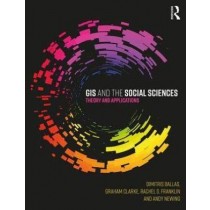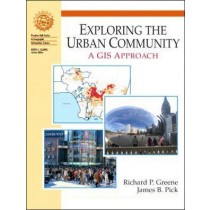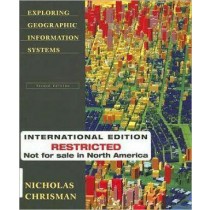Geography
-

Global Migration
Pages: 262,
Specialty: Geography,
Publisher: Taylor & Francis,
Publication Year: 2016,
Cover: Hardback,
Dimensions: 189x246mm
Global Migration provides a clear, concise, and well-organized discussion of historical patterns and contemporary trends of migration, while guiding the readers through an often difficult and politicised topic. Aimed primarily at undergraduate and Master's students, the text encourages the readers to reflect on economic processes, politics, immigrant lives and raises debates about inclusion, exclusion, and citizenship. The text critically highlights the global character of contemporary migration and the importance of historical context to current processes and emphasises the role of gender, race and national ideologies in shaping migration experiences. Using over a decade of their own insight into teaching undergraduate migration courses in the US and the UK, and the knowledge and understanding of the subject they have acquired as migration researchers, the authors offer an accessible and student-friendly manner for readers to understand and explore the complex issue of migration. The book features numerous international case studies, a chapter dedicated to the perspective of the immigrants themselves, as well as key terms and further readings at the end of each chapter. Both theoretically and empirically informed Global Migration examines the subject in a holistic and expansive way. It will equip students with an understanding of the complex issues of migration and serve as a guide for instructors in structuring their courses and in identifying important bodies of scholarly research on migration issues.
Weight: 0.5 KG
Learn More -

GIS: An Introduction to Mapping Technologies
Pages: 348,
Specialty: Geography,
Publisher: Taylor & Francis,
Publication Year: 2019,
Cover: Hardback,
Dimensions: 156x235x22.86mm
Over the past few decades the world has been organized through the growth and integration of geographic information systems (GIS) across public and private sector industries, agencies, and organizations. This has happened in a technological context that includes the widespread deployment of multiple digital mobile technologies, digital wireless communication networks, positioning, navigation and mapping services, and cloud-based computing, spawning new ways of imagining, creating, and consuming geospatial information and analytics. GIS: An Introduction to Mapping Technologies is written with the detached voices of practitioner scholars who draw on a diverse set of experiences and education, with a shared view of GIS that is grounded in the analysis of scale-diverse contexts emphasizing cities and their social and environmental geographies. GIS is presented as a critical toolset that allows analysts to focus on urban social and environmental sustainability. The book opens with chapters that explore foundational techniques of mapping, data acquisition and field data collection using GNSS, georeferencing, spatial analysis, thematic mapping, and data models. It explores web GIS and open source GIS making geospatial technology available to many who would not be able to access it otherwise. Also, the book covers in depth the integration of remote sensing into GIS, Health GIS, Digital Humanities GIS, and the increased use of GIS in diverse types of organizations. Active learning is emphasized with ArcGIS Desktop lab activities integrated into most of the chapters. Written by experienced authors from the Department of Geography at DePaul University in Chicago, this textbook is a great introduction to GIS for a diverse range of undergraduates and graduate students, and professionals who are concerned with urbanization, economic justice, and environmental sustainability. show more
Weight: 0.77 KG
Learn More -

GIS and the Social Sciences
Pages: 320,
Specialty: Geography,
Publisher: Taylor & Francis,
Publication Year: 2018,
Cover: Paperback,
Dimensions: 191x248x20.32mm
GIS and the Social Sciences offers a uniquely social science approach on the theory and application of GIS with a range of modern examples. It explores how human geography can engage with a variety of important policy issues through linking together GIS and spatial analysis, and demonstrates the importance of applied GIS and spatial analysis for solving real world problems in both the public and private sector. The book introduces basic theoretical material from a social science perspective and discusses how data is handled in GIS, what the standard commands within GIS packages are, and what they can offer in terms of spatial analysis. It covers the range of applications that GIS has been primarily used for in the social sciences, offering a global perspective of examples at a range of spatial scales. The book explores the use of GIS in crime, health, education, retail location, urban planning, transport, geodemographics, emergency planning and poverty/income inequalities. It is supplemented with practical activities and datasets which are linked to the content of each chapter and provided on a companion website. The examples are written using ArcMap to show how the user can access data and put the theory in the textbook to applied use using proprietary GIS software. This book serves as a useful guide to a social science approach to GIS techniques and applications. It provides a range of modern applications of GIS with associated practicals to work through, and demonstrates how researcher and policy makers alike can use GIS to plan services more effectively. It will prove to be of great interest to geographers, as well as the broader social sciences, such as sociology, crime science, health, business and marketing. show more
Weight: 0.66 KG
Learn MoreKWD11.70 -

Geosystems: An Introduction to Physical Geography, 9E
Pages: 696,
Specialty: Geography,
Publisher: Pearson,
Publication Year: 2014,
Cover: Paperback,
Dimensions: 216x274x28mm
For Introductory Physical Geography Courses Among the most highly regarded in physical geography, Robert Christopherson's bestselling texts are known for their meticulous attention to detail, currency, accuracy, and rich integration of climate change science. Geosystems: An Introduction to Physical Geography, Ninth Edition is uniquely organized to present Earth systems topics as they naturally occur: atmosphere, hydrosphere, lithosphere and biosphere. This interconnected and organic systems-based approach is highlighted in the strong pedagogical tools, structured learning path, and up-to-date information found in the text. This new edition presents bold new features that cultivate an active learning environment both in and outside the classroom. The Ninth Edition can be made available with MasteringGeography(TM) , the most effective and widely used online tutorial, homework, and assessment system for the sciences. Note: You are purchasing a standalone product; MasteringGeography does not come packaged with this content. MasteringGeography is not a self-paced technology and should only be purchased when required by an instructor. MasteringGeography will provide an interactive and engaging learning experience for your students. Here's how: *Personalize learning with MasteringGeography: MasteringGeography provides students with engaging and interactive experiences that coach them through introductory physical geography with specific wrong-answer feedback, hints, and a wide variety of educationally effective content. *Leverage strong pedagogical tools and a structured active learning path: The text reinforces central hallmark physical geography themes of Earth systems, human-Earth relations, and global climate change by providing a consistent framework for mastering chapter concepts. *Teach with current and relevant content. An emphasis on currency provides students with compelling reasons for learning physical geography.show more
Weight: 1.44 KG
Learn MoreKWD15.00 -

Geographic Information Science and Systems 4e
Pages: 496,
Specialty: Geography,
Publisher: Wiley,
Publication Year: 2015,
Cover: Paperback,
Dimensions: 214x276x22mm
Effective use of today s vast geographic information (GI) resources requires more than just powerful technology for problem solving. It requires science to help us understand the way the world works, and to help us devise effective procedures for making decisions. Three previous editions have established this text as a defining multidisciplinary treatment of the scientific principles that underpin the use of geographic information technologies for problem solving. This extensively revised and updated edition provides a guide to the enduring scientific principles and information systems that support effective use of today s GI. It also provides a primer on essential methods for analysis of GI, and the ways in which effective management of GI informs policy and action.
Weight: 1.1 KG
Learn MoreKWD14.40 -

Exploring the Urban Community: A GIS Approach
Pages: 512,
Specialty: Geography,
Publisher: Pearson,
Publication Year: 2000,
Cover: Paperback,
Dimensions: 210.8x276.9x22.9mm
For courses in Urban Geography and Urban Planning. This book covers all the important traditional urban geography topics such as urban spatial structure, central place theory, neighborhood change, and industrial locations analysis, and also expands upon these to include contemporary topics such as global cities, gender, activism, technology, postmodernism, trans-nationalism, sexuality, and environmental justice. In addition to broad and very current coverage, this contemporary, well-written treatment of urban geography features strong integration of GIS technologies, and thus gives instructors the option to utilize geographic information systems in their teaching. The integration of GIS benefits students by its use as an analytic tool to understand urban phenomenon, and by its importance as a skill for future jobs. The GIS coverage provides a valuable tool for professors to use to teach and engage students in active learning.show more
Weight: 1.29 KG
Learn MoreKWD9.00 -

Exploring Geographical Information Systems, 2e
Pages: 320,
Specialty: Geography,
Publisher: Wiley,
Publication Year: 2003,
Cover: Paperback,
Dimensions: 191x236x13mm
Uses case studies to examine the various applications of each type of geographic information. Considers geographic information as a technical problem, an empowering application, a pure science endeavor, an academic pursuit and a social necessity. Provides a wide range of examples and applications to help readers understand technical discussions.show more
Weight: 0.48 KG
Learn More -

Exploring Geographic Information Systems, 2nd Edition
Pages: 320,
Specialty: Geography,
Publisher: Wiley,
Publication Year: 2002,
Cover: Paperback,
Dimensions: 190x230x14mm
Uses case studies to examine the various applications of each type of geographic information. Considers geographic information as a technical problem, an empowering application, a pure science endeavor, an academic pursuit and a social necessity. Provides a wide range of examples and applications to help readers understand technical discussions.show more
Weight: 0.54 KG
Learn MoreKWD12.60 -

Essentials of Physical Geography
Pages: 650,
Specialty: Geography,
Publisher: Cengage,
Publication Year: 2003,
Cover: Hardback,
Dimensions: 222x278x22mm
'Essentials of Physical Geography' uses the combined expertise of three respected geographers to create the ultimate tool for illustrating physical geography concepts and helping students bridge the gap between scientific theory, practical application and the human-environmental interface.show more
Weight: 1.74 KG
Learn More -

Environmental Disasters
Pages: 64,
Specialty: Geography,
Publisher: NA,
Publication Year: 2008,
Cover: Paperback,
Dimensions: 197x254x5mm
Weight: 0.23 KG
Learn MoreKWD9.00



